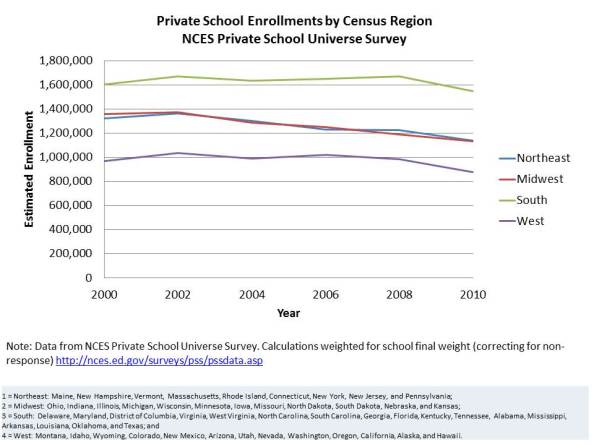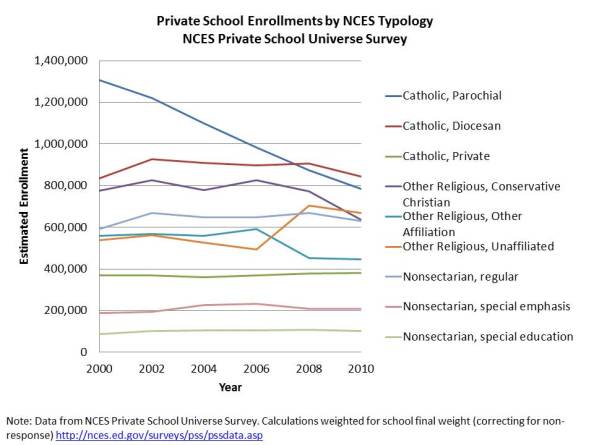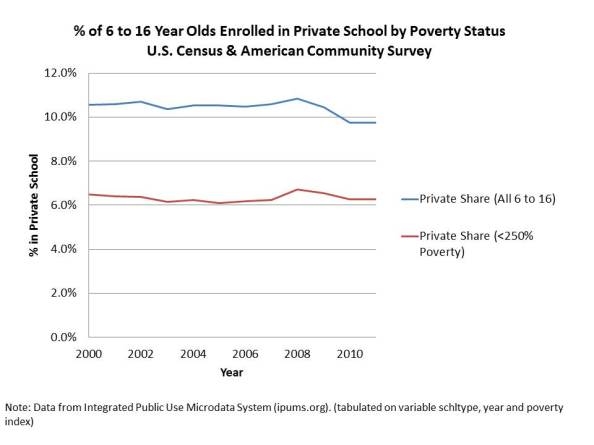The Death of Private Schools is Greatly Exaggerated (& Misrepresented!)
As I’ve explained on previous posts, specific to New Jersey, claims of the dying private sector in education are grossly over exaggerated.
These days, such claims are often over exaggerated with the purpose of framing some broad policy interest in supporting private schools. That is, some need for immediate public policy attention to the problem – some reason to consider how to better integrate our private sector schools into the provision of the public good of elementary and secondary education.
It is argued broadly that the loss of our ever important private sector of schooling is a threat to educational excellence – or even national security. That this loss is of particular concern for our middle and lower income populations who have now lost access to private sector schooling.
In short, policymakers must act swiftly to stabilize this “too big to fail” sector of schooling that is critical to the future of low income children in America. This is not a religious issue. It’s a public interest issue. It has no religious boundaries. No specific religious identity. It is entirely neutral of religion. Or is it?
Indeed, I’m painting a caricature of recent arguments regarding private schooling and the public good. But I would argue that this caricature is reasonably representative of Checker Finn’s recent Fordham Institute editorial on “Why Private Schools are Dying Out.”
Checker begins with bold claims of a dying private schooling industry… though noting that elite schools are doing just fine. His precision of analysis ends about there – elites okay… everyone else dying. Checker points to “other countries” (an ambiguity that drives me nuts… and is entirely pointless in its absurd imprecision), noting:
Most other modern countries have essentially melded their private education sectors into their systems of public financing
The implication to be drawn (though not entirely clearly stated) from Checker’s rant on the decline of private schooling in America is that we too must find ways to act like “other modern countries” (which obviously trounce us on international tests) and meld our public and private systems with public funding toward the greater public good.
To believe this line of reasoning, one must be entirely ignorant of the social/cultural religious demography of the United States and the history, long past and recent of private schooling in America (some data provided here). One would also have to ignore any and all publicly available data from which one might actually explore patterns of private school enrollment over time. I just can’t do that. It’s too easy to check.
Evidence from the NCES Private School Universe Survey
Let’s start with the national biennial survey of private schools conducted by the National Center for Education Statistics. First, here are estimated total private school enrollments by grade level.
As we can see, elementary enrollments do appear to be dropping.
Now, here it is by region. There appears to be some decline in the Northeast and Midwest. But, the south and West are relatively stable.
Now, by affiliation, or in the NCES dataset, an aggregate typology they’ve created. Here what we see is that most sectors of private schooling in the U.S. are, in fact stable. One is not. Parochial Catholic schools have declined appreciably in the past decade, assuming these data to be accurate (with the decline starting well before that). Yes, it’s a big sub-sector within private schooling. Formerly the biggest. But it is one specific sub-sector.
Evidence from Census Data and the American Community Survey
Now, let’s take a look at Census Bureau data from 2000 to 2011, including a breakout of children from lower income families (those below 250% of the income level for poverty). Here, I look at 6 to 16 year olds because, in states where kindergarten is half-day, larger shares attend private schools, and where full day kindergarten increases by policy change, private school shares decline. Here I’m trying to capture the core of the school aged population.
What we see is some drop among the total population, but the lower income population is relatively stable.
Clarifying the Policy Inferences
First and foremost, the graphs here are still far too highly aggregated. This issue requires much more parsing by state, metro area, by affiliation and grade ranges, and so on. National averages of anything in the U.S. tend not to be very useful.
That aside, what we see here is that lower income families are enrolled at roughly a constant rate over time. They are not declining. Not losing substantial access. That said, they have much less access than their higher income peers to begin with.
Further, most types of private schools have remained stable over time – nationally. There is an apparent small shock between 2008 and 2010. Catholic Church affiliated schools have indeed declined in enrollment over the long haul, and significantly. This includes especially parochial, largely elementary schools, and recently, church affiliated Diocesan upper schools.
Overall, high school enrollments are up. Middle school enrollments are stable. Elementary school enrollments are down, and largely due to the decline in Catholic parochial elementary schools.
So, let’s be sure to see the public policy question for what it is. And to see it for what it is, we must start with a reasonable look at the available data.
Private schooling isn’t generally in decline. Church affiliated Catholic schooling is. There may be a variety of reasons for this. Middle class Catholic families have migrated out of the cities for decades. Urban catholic school enrollments have become increasingly non-Catholic (in many regions/cities), arguably altering (if not compromising) the Catholic mission of those schools. Non-Catholic low income families in cities have been provided more non-religious choices, through expanded charter schooling (perhaps the primary reason?). While attempting to uphold their service mission, holding down tuition and providing breaks for low income families, Catholic schools have become increasingly cash strapped. Notably, Catholic schools today operate with a much smaller share of in-kind, Church staff than they used to. Staffing costs have risen dramatically.
So then, if we accept these trends among one subset of private schools as being a substantial national policy concern (which some may), then the question is not broadly how to better integrate private entities of all stripes into the provision of elementary and secondary education as a public good, but rather about whether we should be using public funding to stabilize a subset of private schools of a single religion – in other words, should we use public dollars to bail out Catholic schools in decline?
When viewed as a taxpayer subsidized bailout of Catholic Church affiliated schooling, these policy proposals are no longer religion neutral – are they? (nor are they particularly good for Catholic education)
This blog post has been shared by permission from the author.
Readers wishing to comment on the content are encouraged to do so via the link to the original post.
Find the original post here:
The views expressed by the blogger are not necessarily those of NEPC.




